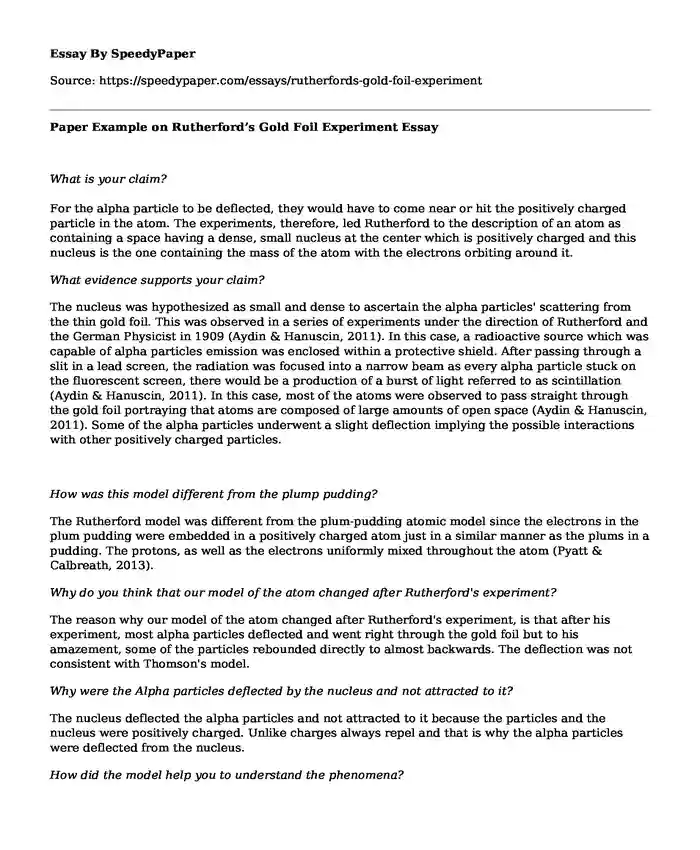What is your claim?
For the alpha particle to be deflected, they would have to come near or hit the positively charged particle in the atom. The experiments, therefore, led Rutherford to the description of an atom as containing a space having a dense, small nucleus at the center which is positively charged and this nucleus is the one containing the mass of the atom with the electrons orbiting around it.
What evidence supports your claim?
The nucleus was hypothesized as small and dense to ascertain the alpha particles' scattering from the thin gold foil. This was observed in a series of experiments under the direction of Rutherford and the German Physicist in 1909 (Aydin & Hanuscin, 2011). In this case, a radioactive source which was capable of alpha particles emission was enclosed within a protective shield. After passing through a slit in a lead screen, the radiation was focused into a narrow beam as every alpha particle stuck on the fluorescent screen, there would be a production of a burst of light referred to as scintillation (Aydin & Hanuscin, 2011). In this case, most of the atoms were observed to pass straight through the gold foil portraying that atoms are composed of large amounts of open space (Aydin & Hanuscin, 2011). Some of the alpha particles underwent a slight deflection implying the possible interactions with other positively charged particles.
How was this model different from the plump pudding?
The Rutherford model was different from the plum-pudding atomic model since the electrons in the plum pudding were embedded in a positively charged atom just in a similar manner as the plums in a pudding. The protons, as well as the electrons uniformly mixed throughout the atom (Pyatt & Calbreath, 2013).
Why do you think that our model of the atom changed after Rutherford's experiment?
The reason why our model of the atom changed after Rutherford's experiment, is that after his experiment, most alpha particles deflected and went right through the gold foil but to his amazement, some of the particles rebounded directly to almost backwards. The deflection was not consistent with Thomson's model.
Why were the Alpha particles deflected by the nucleus and not attracted to it?
The nucleus deflected the alpha particles and not attracted to it because the particles and the nucleus were positively charged. Unlike charges always repel and that is why the alpha particles were deflected from the nucleus.
How did the model help you to understand the phenomena?
The model helped me in understanding the phenomena since it involved the firing of the positively charged particles at a gold-metal foil piece. The alpha particles that were shot at the gold foil were positively charged and often, the alpha particles would pass through the foil with no any change in their paths (Pyatt & Calbreath, 2013). This is actually what was expected if the plum pudding model by Thomson was correct.
What specific concepts did you learn from this assignment from the point of view of a. the structure of atom b. argumentative writing?
From this assignment, I have learned that an atom contains a small positively charged nucleus at the centre which contains most of the atom's mass with the electrons orbiting around it. The negative electrons which electrically balanced the nucleus which is positively charged were regarded as the circular orbits about the nucleus. The force of attraction which is electrostatic between the electrons and the nucleus is related to force of attraction between the sun and the revolving planets. In this case, most of the planetary atoms were just a space without any form of resistance to the alpha particles' passage.
References
Aydin, S., & Hanuscin, D. L. (2011). Secret in the margins: Rutherford's gold foil experiment. The Science Teacher, 78(7), 56. https://socratic.org/questions/what-did-rutherford-s-gold-foil-experiment-tell-about-the-atom
Pyatt, K., & Calbreath, D. (2013). Atomic Structure. https://www.britannica.com/science/Rutherford-model#targetText=Most%20alpha%20particles%20were%20observed,charged%20particles%20within%20the%20atom.
Cite this page
Paper Example on Rutherford's Gold Foil Experiment. (2023, Feb 12). Retrieved from https://speedypaper.com/essays/rutherfords-gold-foil-experiment
Request Removal
If you are the original author of this essay and no longer wish to have it published on the SpeedyPaper website, please click below to request its removal:
- Reflection Essay Sample on Scott Thornbury's Article Slow-Release Grammar
- Statistics Essay Sample: Multiple Regression Analysis
- Free Essay: Computer Use by Children and Adolescents Be Carefully Supervised and Monitored
- Vision and Opportunity - The Personal Business Plan Example
- Free Essay: Reformational View of Vocation
- Essay Example on Fair Cross-Section of Jurors
- Free Paper Sample on Self-Efficacy and Emotional Intelligence
Popular categories





